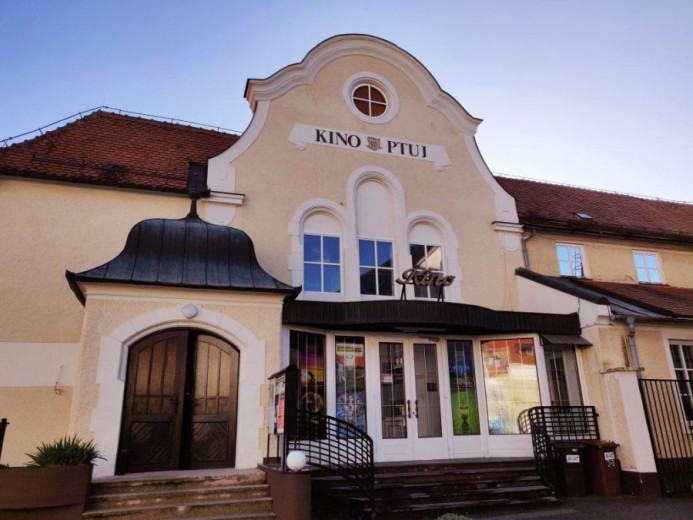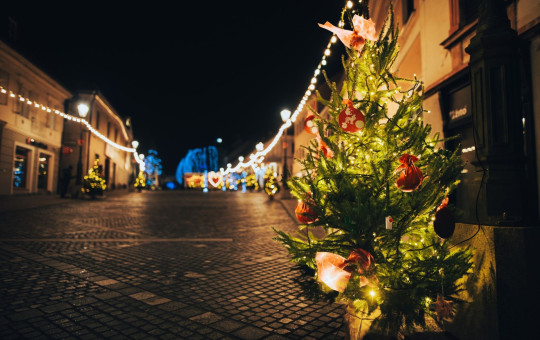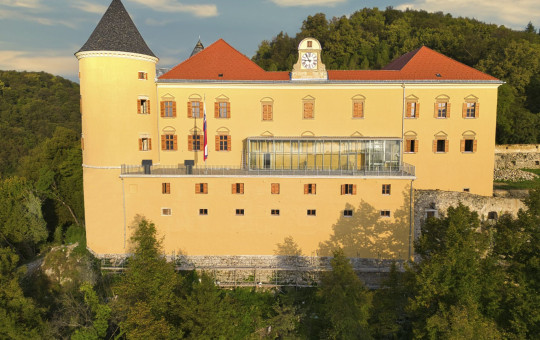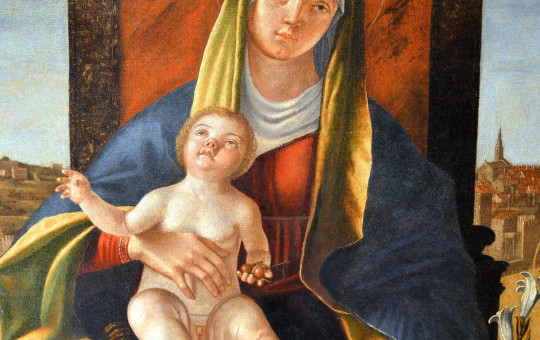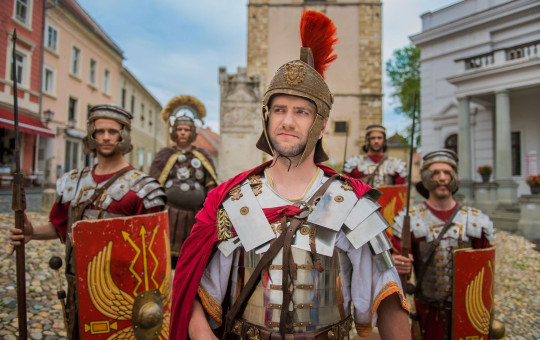Date: 18. November 2025
Time to read: 2 min
Ptuj, founded on the banks of the Drava River and inhabited for thousands of years, is today one of Central Europe's richest archaeological and cultural towns. Its renown reaches far beyond Slovenia's borders – not only because it was named Best Cultural Heritage Town in Europe 2026, but also thanks to its remarkable density of preserved traces of the past.
-
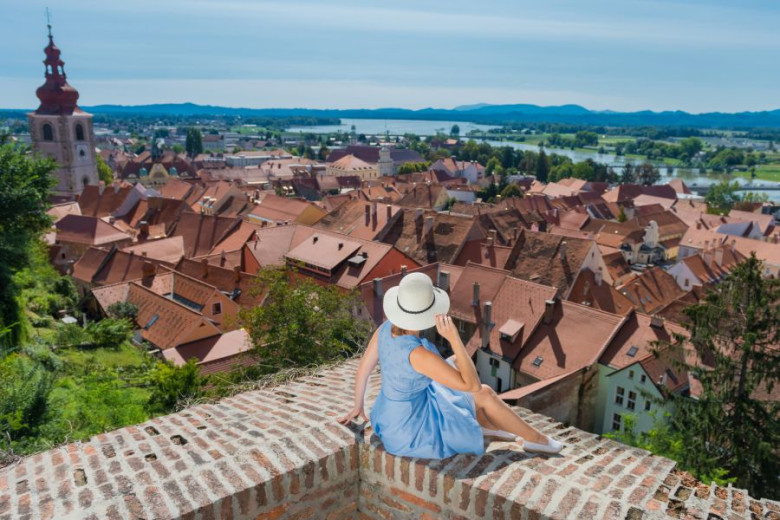 Ptuj is a gem northeastern Slovenia and the oldest Slovenian town. A walk through Ptuj will take you past ancient Roman monuments and magnificent medieval facades. Photo: Mankica Kranjec
Ptuj is a gem northeastern Slovenia and the oldest Slovenian town. A walk through Ptuj will take you past ancient Roman monuments and magnificent medieval facades. Photo: Mankica Kranjec
-
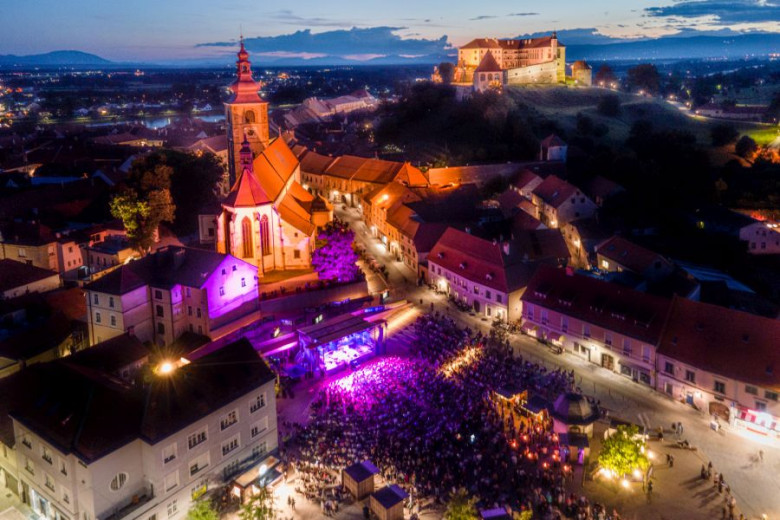 Summers are the time for the contemporary art festival Art Stays, the Arsana music festival, and Days of Poetry and Wine, as well as the Roman games, medieval reenactments, and traditional fairs. Photo: Albin Bezjak
Summers are the time for the contemporary art festival Art Stays, the Arsana music festival, and Days of Poetry and Wine, as well as the Roman games, medieval reenactments, and traditional fairs. Photo: Albin Bezjak
-
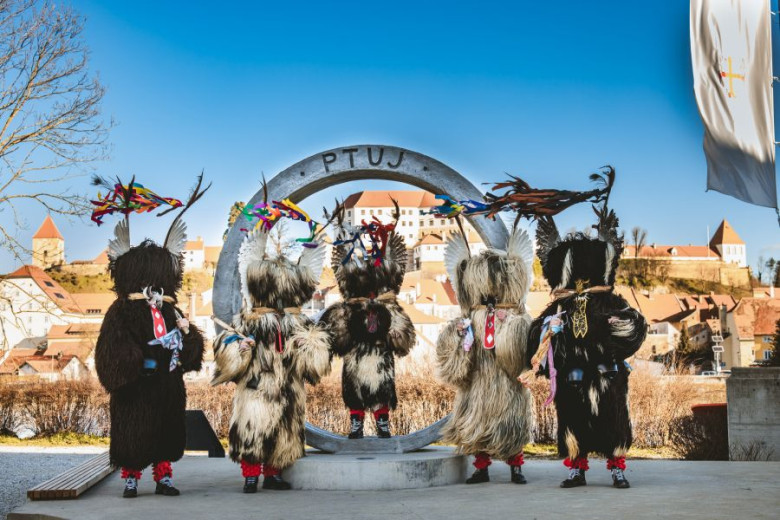 The Ptuj Ring was made by the company Talum in 2019, which gifted the frame to the city on the 1,950th anniversary of Ptuj’s first mention in written sources, and at the same time to itself on the factory’s 65th anniversary. Photo: TIC Ptuj
The Ptuj Ring was made by the company Talum in 2019, which gifted the frame to the city on the 1,950th anniversary of Ptuj’s first mention in written sources, and at the same time to itself on the factory’s 65th anniversary. Photo: TIC Ptuj
In the former Roman city of Poetovia, a powerful administrative and military structure once operated, and the cult of Mithras flourished here as one of its most influential European centres.
-
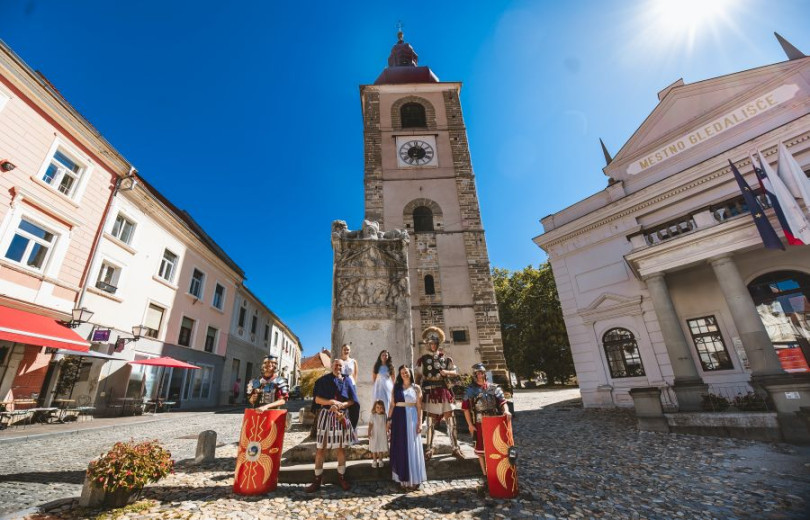 By the 1st century BC, the settlement was controlled by Ancient Rome as part of the Pannonian province. In 69 AD, Vespasian was elected Roman Emperor by the Danubian legions in Ptuj, and the first written mention of the city of Ptuj is from the same year. Photo: TIC Ptuj
By the 1st century BC, the settlement was controlled by Ancient Rome as part of the Pannonian province. In 69 AD, Vespasian was elected Roman Emperor by the Danubian legions in Ptuj, and the first written mention of the city of Ptuj is from the same year. Photo: TIC Ptuj
-
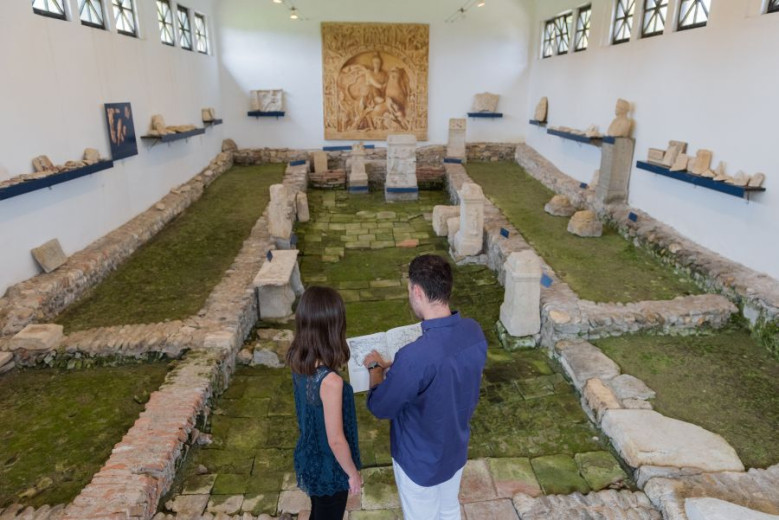 A preserved Roman Mithraeum in Ptuj featuring stone altars, side benches, and a central relief of Mithras slaying the bull. The site showcases remains of the mystery cult once practiced by soldiers and merchants in ancient Poetovio, offering a glimpse into its ritual setting. Photo: Mankica Kranjec
A preserved Roman Mithraeum in Ptuj featuring stone altars, side benches, and a central relief of Mithras slaying the bull. The site showcases remains of the mystery cult once practiced by soldiers and merchants in ancient Poetovio, offering a glimpse into its ritual setting. Photo: Mankica Kranjec
Roman, Baroque, and Medieval Treasures
Ptuj Castle, with its outstanding collection of nearly 350 musical instruments, ranks among the most comprehensive organological collections in this part of Europe.
Among its highlights are a Roman tibia from the 2nd - 3rd centuries and a masterfully crafted lute by Andreas Berr from 1694 - only one other example survives worldwide.
The collection also includes Renaissance zithers, violins, rare oriental instruments and preserved Baroque organ parts, offering a unique window into the musical evolution of Central Europe. Its exceptional value lies in its broad timeline, from antiquity to the late Baroque, which places it among Europe's finest museum collections.
-
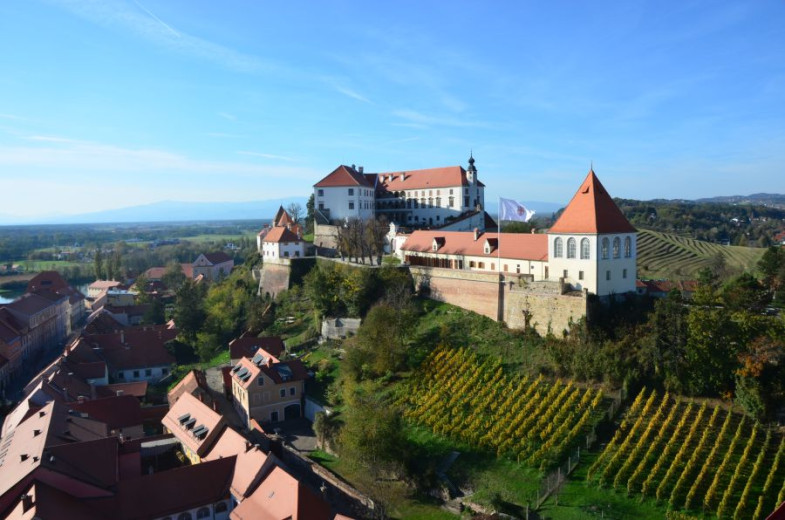 The Ptuj Castle also offers a picture-perfect view over the tiled roofs and cobbled streets of the oldest Slovenian city. Photo: Simon Hojnik
The Ptuj Castle also offers a picture-perfect view over the tiled roofs and cobbled streets of the oldest Slovenian city. Photo: Simon Hojnik
-
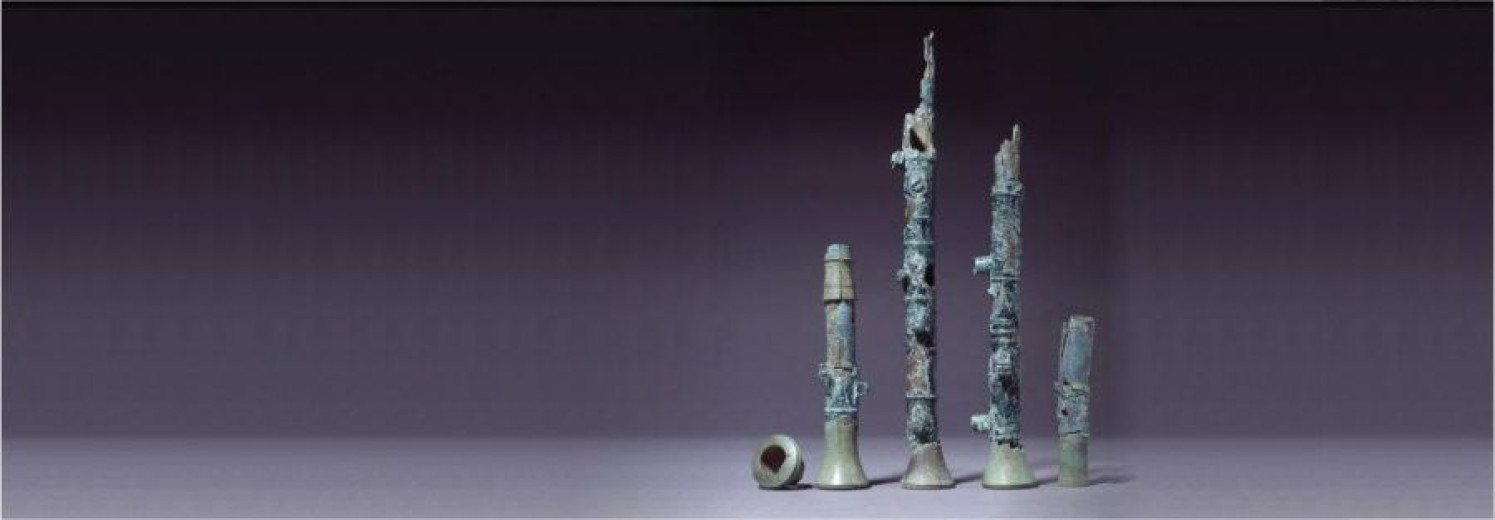 This instrument from the 2nd or 3rd century, called an “aulos” or “tibia”, is a rarity of international significance. Its precise mechanism with spinning rings for covering the holes reveals a technically perfected musical instrument, made for professional musicians. Photo: TIC Ptuj
This instrument from the 2nd or 3rd century, called an “aulos” or “tibia”, is a rarity of international significance. Its precise mechanism with spinning rings for covering the holes reveals a technically perfected musical instrument, made for professional musicians. Photo: TIC Ptuj
-
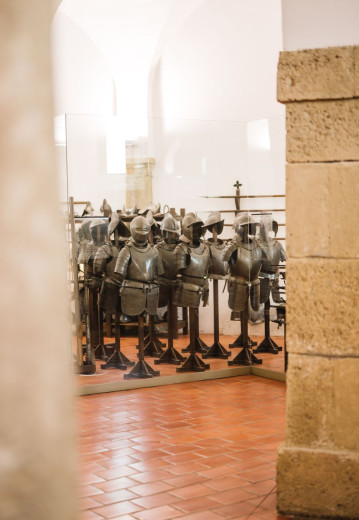 The photo shows the medieval and Renaissance arms and armour collection in Ptuj Castle, featuring helmets, breastplates and polearms. This weapons hall, part of the Ptuj–Ormož Regional Museum, is located on the ground floor of the castle. Photo: Stanko Kozel
The photo shows the medieval and Renaissance arms and armour collection in Ptuj Castle, featuring helmets, breastplates and polearms. This weapons hall, part of the Ptuj–Ormož Regional Museum, is located on the ground floor of the castle. Photo: Stanko Kozel
-
 The Gothic interior of St. George’s Church in Ptuj features ribbed vaults, a central nave and a richly decorated main altar illuminated by tall stained-glass windows. Photo: Mankica Kranjec
The Gothic interior of St. George’s Church in Ptuj features ribbed vaults, a central nave and a richly decorated main altar illuminated by tall stained-glass windows. Photo: Mankica Kranjec
A landmark no visitor to the old town can miss is the Orpheus Monument, the oldest public monument in Slovenia. Having served as the town pillory in the Middle Ages, it combines ancient mythological iconography with the social functions of later centuries. Constructed from originally unrelated pieces, it reflects its long-term use, alterations and reinterpretations of the urban space.
Such examples of Roman artefacts surviving in an urban setting are rare in Europe.
-
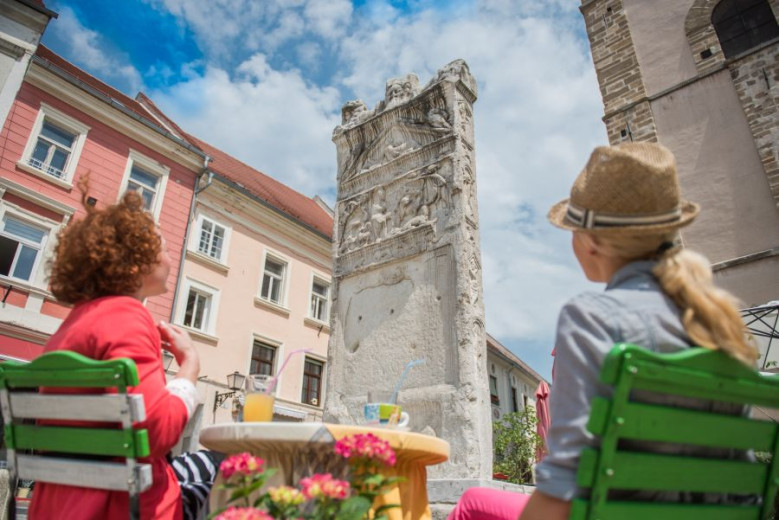 This marble monument was erected to honor the memory of Marcus Valerius Verus, who was the mayor of Poetovio (Ptuj) in the 2nd century AD. The five-meter tall monolith is still standing where it was raised by the Romans. In the middle ages the monument, ornamented with scenes from the myth of Orpheus, was used as a pillory. Photo: Mankica Kranjec
This marble monument was erected to honor the memory of Marcus Valerius Verus, who was the mayor of Poetovio (Ptuj) in the 2nd century AD. The five-meter tall monolith is still standing where it was raised by the Romans. In the middle ages the monument, ornamented with scenes from the myth of Orpheus, was used as a pillory. Photo: Mankica Kranjec
Just steps away stands the Dominican monastery, founded in the 13th century – an architectural fusion of Gothic, Renaissance and Baroque elements.
Here, visitors can explore the lapidarium, a numismatic collection and a reconstruction of Mithraeum II.
The cloister walls reveal three centuries of frescoes, illustrating artistic connections between Styria, Tyrol and the wider Alpine region. The collection of Roman inscriptions found within the complex ranks among Slovenia's finest.
Ptuj is also home to another gem of ecclesiastical architecture. Ptuj’s Minorite Monastery, founded in the 13th century, blends early Gothic architecture with later Baroque additions. Severely damaged in WWII but fully restored, it now serves as a vibrant cultural venue.
Highlights include the Gothic Ptuj Madonna, richly crafted Baroque altars, a 5,000-volume historic library with rare works, and an ornate 17th-century refectorium featuring stucco and frescoes.
Today it remains a site of heritage, music, and learning.
-
 After the fires and bombing, the 13th-century Minorite monastery was renovated. Photo: TIC Ptuj
After the fires and bombing, the 13th-century Minorite monastery was renovated. Photo: TIC Ptuj
-
 Minorite monastery boasts a library with over 5000 books, some of them dating as far back as the 16th century. Photo: TIC Ptuj
Minorite monastery boasts a library with over 5000 books, some of them dating as far back as the 16th century. Photo: TIC Ptuj
-
 Corridors of the Dominican Monastery in Ptuj feature Gothic arches and ribbed vaults, once used for monastic life. Today they serve as a restored cultural venue hosting exhibitions and events. Photo: Mankica Kranjec
Corridors of the Dominican Monastery in Ptuj feature Gothic arches and ribbed vaults, once used for monastic life. Today they serve as a restored cultural venue hosting exhibitions and events. Photo: Mankica Kranjec
A town of wine and ritual traditions
Ptuj has matured alongside its wine for centuries. Slovenia's oldest wine cellar has been ageing wine for more than 700 years, representing one of the longest continuous winemaking traditions in the country.
Beneath the castle hill grows a descendant of the world's oldest grapevine - a symbol of perseverance and the deep-rooted wine heritage of the Štajerska region.
Historical winemaking records show that Ptuj exported wine to noble courts in Austria and Hungary, and used wooden barrels crafted from specially selected Haloze oak, renowned for its durability.
-
 According to an ancient belief, Kurent is a demon chasing winter away and calling spring to the country. In December 2017, UNESCO inscribed the “Door-to- door rounds of Kurent” to the Representative List of the Intangible Cultural Heritage of Humanity. Photo: Stanko Kozel
According to an ancient belief, Kurent is a demon chasing winter away and calling spring to the country. In December 2017, UNESCO inscribed the “Door-to- door rounds of Kurent” to the Representative List of the Intangible Cultural Heritage of Humanity. Photo: Stanko Kozel
-
 The opening of the KURENT HOUSE places Kurent/Korant in a place of historical importance. It is the result of the efforts of interested societies that have been preserving the heritage of Kurent/Korant and its rituals. The idea for the Kurent House was conceived and realized by the Association of Kurent Societies, which comprises 25 societies with over 1,100 members. Photo: Stanko Kozel
The opening of the KURENT HOUSE places Kurent/Korant in a place of historical importance. It is the result of the efforts of interested societies that have been preserving the heritage of Kurent/Korant and its rituals. The idea for the Kurent House was conceived and realized by the Association of Kurent Societies, which comprises 25 societies with over 1,100 members. Photo: Stanko Kozel
-
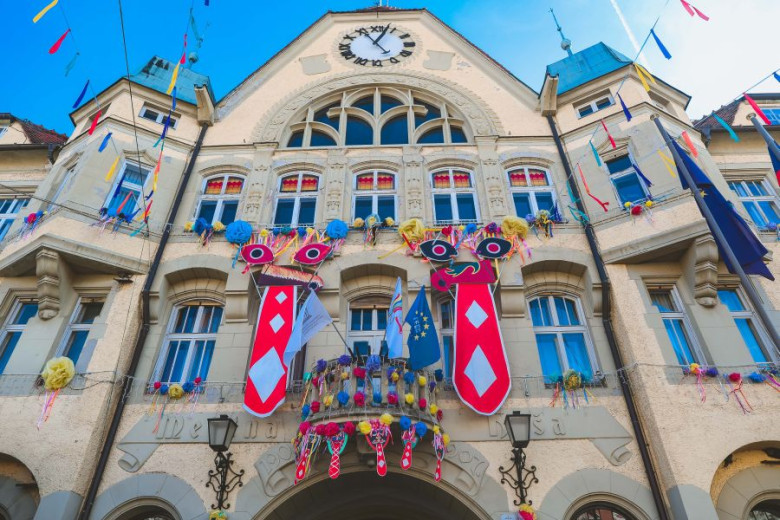 Ptuj’s 1907 neo-Renaissance Town Hall, designed by Max Ferstl, is shown festively decorated for Kurentovanje, when the building becomes a vibrant backdrop to Slovenia’s most famous carnival. Photo: Stanko Kozel
Ptuj’s 1907 neo-Renaissance Town Hall, designed by Max Ferstl, is shown festively decorated for Kurentovanje, when the building becomes a vibrant backdrop to Slovenia’s most famous carnival. Photo: Stanko Kozel
-
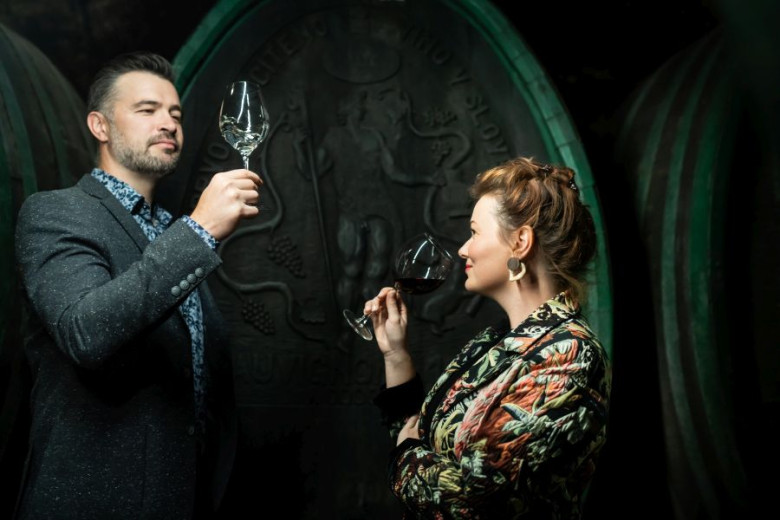 The oldest wine cellar in Slovenia has stored the best wine from the Haloze Hills and the Slovenske Gorice Hills for 700 years. Photo: Stanko Kozel
The oldest wine cellar in Slovenia has stored the best wine from the Haloze Hills and the Slovenske Gorice Hills for 700 years. Photo: Stanko Kozel
-
 The vine beneath Ptuj Castle is an ancient grapevine cherished for its heritage and yearly harvest. Photo: Simon Hojnik
The vine beneath Ptuj Castle is an ancient grapevine cherished for its heritage and yearly harvest. Photo: Simon Hojnik
In winter, the town becomes the stage for one of Central Europe's most recognisable rituals: the procession of the kurenti, inscribed on UNESCO's list of Intangible Cultural Heritage.
Their cowbells – some weighing up to 40 kilograms – symbolically chase away winter and evil spirits. They traditionally formed into groups known as "hordes", which is a rarity among European carnival customs. Kurentovanje, the masked rite of spring, is therefore not merely a folklore feature, but a vibrant, dynamic ritual that preserves local identity within a global context.
The charm of the Ptuj Town Cinema
Among Ptuj's cultural treasures is the Ptuj Town Cinema, considered the oldest still-operating Slovenian cinema and one of the oldest in the world. Its first projection dates back to 1897.
With a history spanning more than 125 years, it remains a vital centre of the town's film culture.
Today, the main hall seats 163 people, and is complemented by a smaller, more intimate auditorium. The cinema is part of the Europa Cinemas network. Thanks to its preserved retro architecture and unique ambiance, it has become an attractive film location: among other things, part of a short film by director Trent Whiddon, submitted for consideration at the Cannes Film Festival, was filmed here, with the cinema serving as an authentic 1950s setting.
In addition to its regular programming, the cinema enriches cultural life with the summer open-air cinema, educational programmes for children and youth, film-themed tea parties and conversations with film-makers. It stands today not only a historical monument, but a living cultural hub that maintains ties with European film production while nurturing its local audience.
A place where European history still moves
The town tower, with its clock featuring the world's longest wooden pendulum - measuring 21 metres - adds to Ptuj's technical heritage. Researchers note that the pendulum was designed specifically for the tower and required static reinforcements, representing an engineering achievement of its time.
Ptuj is undoubtedly a town brimming with stories. You only have to discover them. Explore its treasures: Roman temples, medieval monasteries, Baroque musical treasures, fine wine, ceremonial masks and a cinema with an international legacy. Here, the flow of millennia continues into everyday life.

